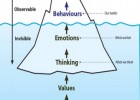
From time to time I come across some stimulating articles that are worth sharing in my opinion. This week a friend sent me a link to this article “The Happiness Plague” It’s fascinating how a great title can draw you in, as this one did for me. However, once I was there and started reading, I found myself getting somewhat annoyed by what I was reading.
I was tempted to immediately log in and make a ‘robust’ comment. What then occurred to me were my own internal responses. Why was I feeling so annoyed, or perhaps even angry? It’s only someone elses opinion. What was this all about? It stopped me in my tracks and I was immediately fascinated as I observed my own internal responses.
Neuro science tells us that if in times where we might be ‘triggered’ to react we have something like one third of a second to notice (in this case) an angry response and in that split second stop and choose a different response. 
This is the stuff of emotional intelligence, self awareness, mindfulness – whatever you like to call it.
For those not yet using this awareness ‘muscle’ their response might be to feel angry and react – in this case I could have logged in, made a robust comment and hit enter. Of course we know in workplace and other situations a person’s stressed response might be to yell, react with unhelpful verbal responses, stamp their feet, and throw a tantrum or any other number of stressed responses. None of which achieve anything other than to further suck the resources from the pre frontal cortex ( the thinking area of the brain) meaning there is lack of clear thinking, and of course could invariably lead to someone else being ‘triggered’ into an equally stressed state. Imagine this happening in teams, workplaces, families.
Learning to stay intimately connected to what you are thinking sounds really simple, but it does take practice and the willingness to ‘stop’ and reappraise if you are tempted to ‘blow up’
A great challenge I set for some clients is to regularly ‘check their thinking’ as they go about their daily tasks. Checking particularly how they are thinking and acting in busy or stressed times. Often, just by noticing what is going on is a tool in itself to build awareness.
Are you up for the challenge to do that for a week or so? If so, I’d love to hear what you notice about the exercise. Please leave a comment.
And after all this you might be wondering what did make me respond to this article. Simplicity and generalisation. It gives a once over lightly to the topics of happiness, resilience and praise. I work with people all the time who experience emotions positive and negative. The point is to firstly, notice what the emotion is and ‘be’ with it – not suppress it. Understand it. Then choose what your next response is.
Of course – negative emotions are part of being human, but that does not mean we have to stay in that negative space while we deal with challenging or unhappy situations. It is simply naive to say that happiness thinking is expecting people to be happy all the time. It is also misleading to imply psychologists, coaches and the like all preach this message. Well trained and qualified professionals know better.
Have a read of the article, would love to hear what you think!




